Samsung UN55C7000WFXZA Owner’s Manual

Contact SAMSUNG WORLDWIDE
If you have any questions or comments relating to Samsung products, please contact the SAMSUNG customer care center.
Comment contacter Samsung dans le monde
Si vous avez des suggestions ou des questions concernant les produits Samsung, veuillez contacter le Service Consommateurs Samsung.
Comuníquese con SAMSUNG WORLDWIDE
Si desea formular alguna pregunta o comentario en relación con los productos de Samsung, comuníquese con el centro de atención al cliente de SAMSUNG.
Country |
Customer Care Center |
Web Site |
Address |
CANADA |
1-800-SAMSUNG (726-7864) |
www.samsung.com |
Samsung Electronics Canada Inc., Customer Service |
|
|
|
55 Standish Court Mississauga, Ontario L5R 4B2 |
|
|
|
Canada |
U.S.A |
1-800-SAMSUNG (726-7864) |
www.samsung.com |
Samsung Electronics America, Inc. 85 Challenger |
|
|
|
Road Ridgefield Park, NJ 07660-2112 |
manual user TV LED
LED TV
user manual
imagine the possibilities
Thank you for purchasing this Samsung product. To receive more complete service, please register your product at
www.samsung.com/register
Model______________ Serial No.______________
© 2010 Samsung Electronics Co., Ltd. All rights reserved. |
BN68-02627A-07 |
|

Figures and illustrations in this User Manual are provided for reference only and may differ from actual product appearance. Product design and specifications may be changed without notice.
Important Warranty Information Regarding Television Format Viewing
See the warranty card for more information on warranty terms.
Wide screen format LED Displays (16:9, the aspect ratio of the screen width to height) are primarily designed to view wide screen format full-motion video. The images displayed on them should primarily be in the wide screen 16:9 ratio format, or expanded to fill the screen if your model offers this feature and the images are constantly moving. Displaying stationary graphics and images on screen, such as the dark sidebars on no expanded standard format television video and programming, should be limited to no more than 5% of the total television viewing per week.
Additionally, viewing other stationary images and text such as stock market reports, video game displays, station logos, web sites or computer graphics and patterns, should be limited as described above for all televisions. Displaying stationary images that exceed the above guidelines can cause uneven aging of LED Displays that leave subtle, but permanent burned-in ghost images in the LED picture. To avoid this, vary the programming and images, and primarily display full screen moving images, not stationary patterns or dark bars. On LED models that offer picture sizing features, use these controls to view different formats as a full screen picture.
Be careful in the selection and duration of television formats used for viewing. Uneven LED aging as a result of format selection and use, as well as burned in images, are not covered by your Samsung limited warranty.
•SAMSUNG ELECTRONICS NORTH AMERICAN LIMITED WARRANTY STATEMENT
Subject to the requirements, conditions, exclusions and limitations of the original Limited Warranty supplied with Samsung Electronics (SAMSUNG) products, and the requirements, conditions, exclusions and limitations contained herein, SAMSUNG will additionally provide Warranty Repair Service in the United States on SAMSUNG products purchased in Canada, and in Canada on SAMSUNG products purchased in the United States, for the warranty period originally specified, and to the Original Purchaser only.
The above described warranty repairs must be performed by a SAMSUNG Authorized Service Center. Along with this Statement, the Original Limited Warranty Statement and a dated Bill of Sale as Proof of Purchase must be presented to the Service Center. Transportation to and from the Service Center is the responsibility of the purchaser. Conditions covered are limited only to manufacturing defects in material or workmanship, and only those encountered in normal use of the product.
Excluded, but not limited to, are any originally specified provisions for, in-home or on-site services, minimum or maximum repair times, exchanges or replacements, accessories, options, upgrades, or consumables.
For the location of a SAMSUNG Authorized Service Center, please call toll-free:
–In the United States : 1-800-SAMSUNG (1-800-726-7864)
–In Canada : 1-800-SAMSUNG
Still image warning
Avoid displaying still images (such as jpeg picture files) or still image elements (such as TV channel logos, panorama or 4:3 image format, stock or news bars at screen bottom etc.) on the screen. Constant displaying of still picture can cause ghosting of LED screen, which will affect image quality. To reduce risk of this effect, please follow below recommendations:
•Avoid displaying the same TV channel for long periods.
•Always try to display a full screen image.
•Reducing brightness and contrast will help to avoid the appearance of after-images.
•Use all TV features designed to reduce image retention and screen burn, refer to proper user manual section for details.
Securing the Installation Space
Keep the required distances between the product and other objects (e.g. walls) to ensure proper ventilation.
Failing to do so may result in fire or a problem with the product due to an increase in the internal temperature of the product.
When using a stand or wall-mount, use parts provided by Samsung Electronics only.
xx If you use parts provided by another manufacturer, it may result in a problem with the product or an injury due to the product falling.
The appearance may differ depending on the product. |
|
|
|
Be careful when you contact the TV because some parts can be somewhat hot. |
|
|
|
Installation with a stand. |
Installation with a wall-mount. |
 4 inches
4 inches
4 inches |
4 inches |
|
4 inches |
4 inches |
4 inches |
|
4 inches |
2 English

Contents |
|
|
Getting Started |
|
|
yy |
List of Features.......................................................... |
4 |
yy |
Accessories............................................................... |
4 |
yy |
Install the Stand......................................................... |
5 |
yy Viewing the Control Panel.......................................... |
6 |
|
yy Viewing the Remote Control...................................... |
7 |
|
yy Connecting to an Antenna......................................... |
8 |
|
yy Plug & Play (Initial Setup)........................................... |
8 |
|
Connections |
|
|
yy Connecting to an AV Device...................................... |
9 |
|
yy Connecting to an Audio Device................................ |
11 |
|
yy Connecting to a PC................................................. |
12 |
|
yy Changing the Input Source...................................... |
13 |
|
Basic Features |
|
|
yy How to Navigate Menus.......................................... |
13 |
|
yy |
Channel Menu........................................................ |
14 |
|
Seeing Channels |
14 |
|
Using Favorite Channels |
14 |
|
Memorizing Channels |
14 |
|
Editing Channels |
15 |
|
Other Features |
15 |
yy |
Picture Menu........................................................... |
16 |
|
Changing the Preset Picture Mode |
16 |
|
Adjusting Picture Settings |
16 |
|
Economical Solutions |
16 |
|
Changing the Picture Options |
17 |
|
Viewing TV using the 3D function |
19 |
|
Setting up the TV with Your PC |
22 |
yy |
Sound Menu............................................................ |
22 |
|
Changing the Preset Sound Mode |
22 |
|
Adjusting Sound Settings |
22 |
|
Sound Settings |
23 |
yy |
Setup Menu............................................................. |
24 |
|
Setting the Time |
24 |
|
Using the Sleep Timer |
24 |
|
Setting the On / Off Timer |
24 |
|
Locking Programs |
25 |
|
Other Features |
26 |
|
Picture In Picture (PIP) |
28 |
yy |
Support Menu......................................................... |
28 |
Advanced Features |
|
|
yy |
Network Connection................................................ |
30 |
|
Connecting to a Wired Network |
30 |
|
Connecting to a Wireless Network |
32 |
yy |
Media Play............................................................... |
37 |
|
Connecting a USB Device |
37 |
|
Connecting to your PC through a network |
37 |
|
Screen Display |
39 |
|
Playing Multiple Files |
42 |
|
Media Play - Additional Functions |
42 |
yy |
Anynet+................................................................... |
44 |
|
Setting Up Anynet+ |
45 |
|
Switching between Anynet+ Devices |
45 |
|
Recording |
46 |
|
Listening through a Receiver |
46 |
|
Troubleshooting for Anynet+ |
47 |
yy |
Internet@TV............................................................. |
48 |
|
Getting Started with Internet@TV |
48 |
|
Setting up Internet@TV |
49 |
|
Using the Internet@TV service |
51 |
|
PROFILE Widget |
53 |
|
Widget Gallery |
53 |
|
Troubleshooting for Internet@TV |
54 |
yy |
AllShare................................................................... |
55 |
|
About AllShare |
55 |
|
Setting Up AllShare |
55 |
Other Information |
|
|
yy |
Assembling the Cables............................................ |
57 |
yy Installing the Wall Mount.......................................... |
58 |
|
yy |
Anti-theft Kensington Lock...................................... |
59 |
yy Securing the TV to the Wall...................................... |
60 |
|
yy |
Troubleshooting....................................................... |
61 |
|
Storage and Maintenance |
64 |
yy |
License.................................................................... |
64 |
yy |
Specifications.......................................................... |
65 |
yy |
Dimensions.............................................................. |
66 |
yy |
Index....................................................................... |
67 |
Check the Symbol!
TOOLS |
t |
|
|
|
|
Note |
Step by Step Guide |
|
This function can be used by pressing the |
Indicates additional information. |
Check here for instructions on how to open |
|
TOOLS button on the remote control. |
|
the relevant submenu within the OSD (on |
|
|
|
screen display). |
ENGLISH
English 3
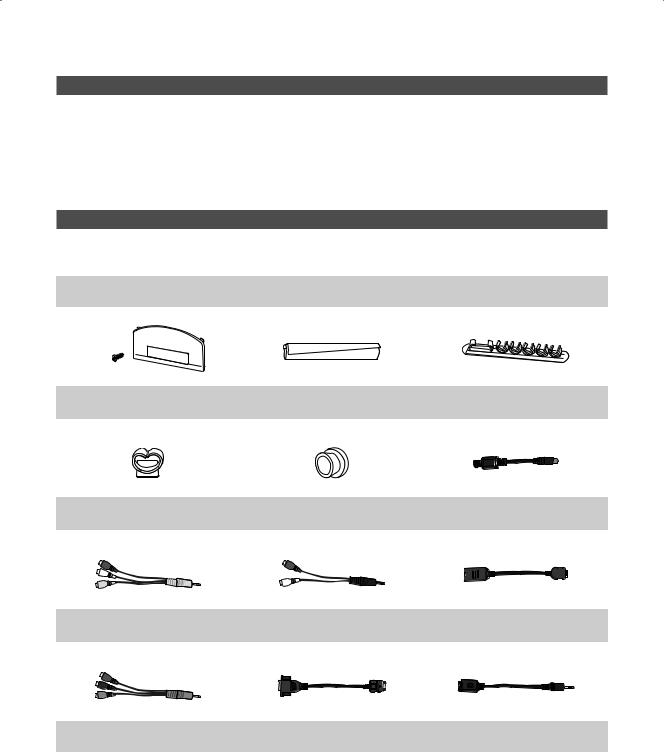
Getting Started
List of Features
yy Excellent Digital Interface & Networking: With a built-in HD digital tuner, nonsubscription HD broadcasts can be viewed without a cable box / STB (Set-Top-Box) satellite receiver.
yy Media Play: Allows you to play music files, pictures, and movies saved on a USB device (p. 37).
yy Internet@TV: You can use various internet services and view useful information and entertaining content (p. 48). yy AllShare: AllShare connects your TV and compatible Samsung mobile phones/devices through a network (p. 55). yy Self Diagnosis: You can check whether picture or sound operate normally (p. 28).
yy 3D: This exciting new feature enables you to view 3D content (p. 18).
Accessories
Please make sure the following items are included with your LED TV. If any items are missing, contact your dealer.The items' colors and shapes may vary depending on the models.
yy |
Remote Control (BN68-01055A) & Batteries (AAA x 2) |
yy |
Cleaning Cloth (BN63-01798B) |
yy |
Owner’s Instructions |
yy |
Warranty Card / Safety Guide / Quick Setup Guide |
(M4 X L8) |
|
|
Blanking Bracket & Screw (1EA) |
Cable Tie |
Holder-Wire (3EA) |
(BN63-06543A) |
(BN61-05596A) |
(BN61-05373A) |
Holder-Wire stand |
Holder-Ring (4EA) |
Antenna Adapter |
||
(BN61-05491A) |
(BN61-05280A) |
(BN39-01154P) |
||
|
|
|
|
|
|
|
|
|
|
|
|
|
|
|
AV Adapter |
Component Sound in Adapter |
LAN Adapter |
(BN39-01154H) |
(BN39-01154G) |
(BN39-01154L) |
Component Adapter |
PC Adapter |
Optical Adapter |
(BN39-01154C) |
(BN39-01154K) |
(BN39-01154M) |
4 English
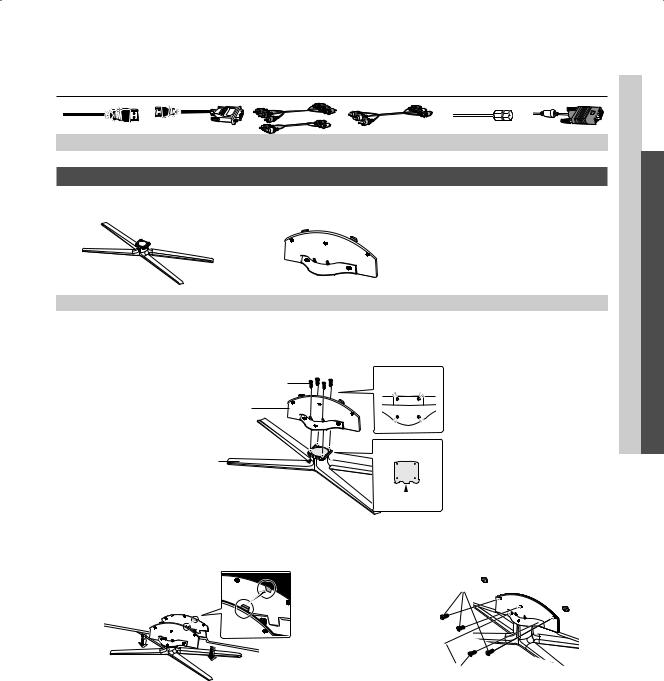
Input Cables (Sold Separately)
HDMI |
HDMI-DVI |
Component |
Composite (AV) |
Coaxial (RF) |
VGA |
|
|
|
|
|
|
Install the Stand
See separate guide for installing the stand.
|
s |
|
s |
|
|
|
|
|
|
s |
s |
|
|
|
s |
Stand (1EA) |
Guide Stand (1EA) |
||
Follow the steps below to connect the TV to the stand.
Screws (M4 X L8) |
|
Top view |
|
|
|
Guide Stand |
s |
s |
|
|
s |
Stand |
|
Front |
|
|
|
|
|
Rear |
|
|
Rear |
1. Connect the Guide Stand to the Stand using four screws (M4 X L8) as shown.


 (M4 X L8)
(M4 X L8)
Screws (9EA)
s
|
s |
s |
s |
|
|
|
s |
s
2 |
Screws (M4 X L8) 

1 |
s
s |
s |
|
|
|
s |
 s
s
2. With your TV upright, connect the TV to the Stand. |
3. Fasten two screws (M4 X L8) at position 1, and then |
|
fasten three screws (M4 X L8) at position 2. |
NOTE
xx Make sure to distinguish between the front and back of the Stand and Guide Stand when assembling them. xx Make sure that at least two persons lift and move the LED TV.
xx Stand the product up and fasten the screws. If you fasten the screws with the LED TV placed down, it may lean to one side.
English 5
 Started Getting 01
Started Getting 01
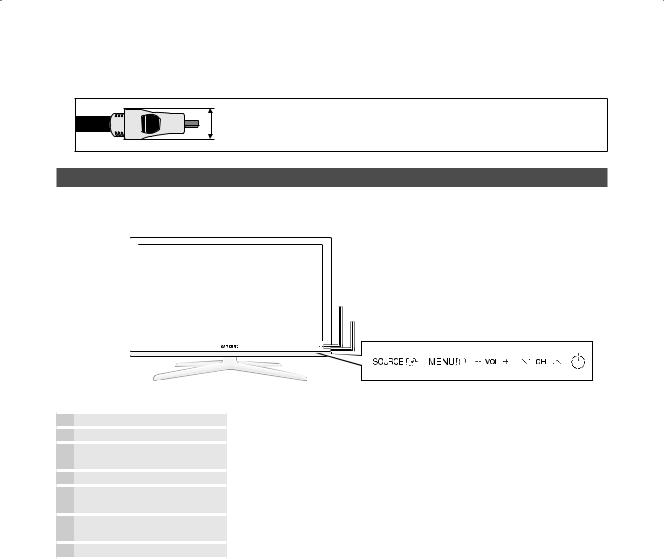
Getting Started
For best cable connection to this product, be sure to use cables with a maximum thickness as below:
yy Maximum thickness - 0.55 inches (14mm)
Viewing the Control Panel
The product color and shape may vary depending on the model.
External electrical noise or contact with objects other than your finger may switch on the LED touchpad.
Remote control sensor
Power Indicator |
Speakers |
|
|
|
|
Remote control sensor |
Aim the remote control towards this spot on the TV. |
|||
Power Indicator |
Blinks and turns off when the power is on and lights up in standby mode. |
|||
SOURCEE |
Toggles between all the available input sources. In the on-screen menu, use this |
|||
|
|
|
button as you would use the ENTEREbutton on the remote control. |
|
MENUm |
Displays an on-screen menu, the OSD (on screen display) of your TV’s features. |
|||
y |
Adjusts the volume. In the OSD, use the ybuttons as you would use the ◄ |
|||
|
|
|
and ► buttons on the remote control. |
|
z |
Changes the channels. In the OSD, use the zbuttons as you would use the |
|||
|
|
|
▼ and ▲ buttons on the remote control. |
|
P(Power) |
Turns the TV on or off. |
|||
Standby mode
Do not leave your TV in standby mode for long periods of time (when you are away on a holiday, for example). A small amount of electric power is still consumed even when the power button is turned off. It is best to unplug the power cord.
6 English

Viewing the Remote Control
Turns the TV on and off.
Displays and selects the available video sources (p. 13).
Press to directly access channels.
Press to select additional channels (digital) being broadcasted by the same station. For example, to select channel “54-3”, press “54”, then press “–” and “3”.
Adjusts the volume.
Brings up the OSD.
Displays the Content View, which includes Channel List, Internet@TV, Media Play, AllShare and 3D.
Quickly select frequently used functions.
Returns to the previous menu.
Buttons used in the Channel List,
Internet@TV, Media Play menu, etc.
Use these buttons in Media Play and Anynet+ modes (p. 37, 44).
( : Controls recording for Samsung recorders that have the Anynet+ feature)
Installing batteries (Battery size: AAA)
POWER |
ON/OFF |
SOURCE |
Turns the remote control light on or |
|
off. When on, the buttons become |
|
illuminated for a moment when pressed. |
|
(Using the remote control with this button |
|
set to ON will reduce the battery usage |
|
time.) |
|
Returns to the previous channel. |
|
PRE-CH |
|
Cuts off the sound temporarily. |
MUTE |
|
|
Changes channels. |
CH LIST |
|
CONTENT |
MENU |
INTERNET |
|
@ TV |
|||
|
|
||
TOOLS |
|
INFO |
RETURN EXIT
A B C D
MEDIA.P YAHOO!
FAV.CH P.SIZE CC
Displays the channel list on the screen (p. 14).
Link to various internet services (p. 48).
Displays information on the TV screen.
Selects the on-screen menu items and changes the values seen on the menu.
Exits the menu.
MEDIA.P: Displays Media Play (p. 37).
YAHOO!: Runs the Yahoo widget. (p. 52).
3D: Sets the 3D mode. (p. 20). FAV.CH: Displays Favorite Channel Lists on the screen (p. 14).
P.SIZE: Selects the picture size (p. 18). CC: Controls the caption decoder (p. 26).
NOTE
xx Use the remote control within 23 feet from the TV.
xx Bright light may affect the performance of the remote control. Avoid use when nearby fluorescent lights or neon signs.
xx The color and shape may vary depending on the model.
 Started Getting 01
Started Getting 01
English 7

Getting Started
Connecting to an Antenna
When the TV is initially powered on, basic settings proceed automatically.Connecting the power cord and antenna.
VHF/UHF Antenna
Antenna Cable (Not Supplied)
Cable
ANT OUT
or
 Antenna Adapter (Supplied)
Antenna Adapter (Supplied)
Plug & Play (Initial Setup)
When the TV is initially powered on, a sequence of on-screen prompts will assist in configuring basic settings. Press the POWERPbutton. Plug & Play is available only when the Input source is set to TV.
To return to the previous step, press the Red button.
1 |
Selecting a language |
2 |
Selecting Store Demo |
or Home Use |
|
3 |
Selecting an antenna |
4 |
Selecting a channel |
5 |
ModeSetting the Clock |
6 |
View the HD |
Connection Guide |
|
7 |
Enjoy the TV. |
Press the ▲ or ▼ button, then press the ENTEREbutton. |
POWER |
|
Select the desired OSD (On Screen Display) language. |
P |
|
Press the ◄ or ► button, then press the ENTEREbutton. |
||
y |
Select the Home Use mode. Store Demo mode is for retail |
|
|
y environments. |
|
yy To return the unit’s settings from Store Demo to Home Use (standard): Press the volume button on the TV. When you
see the volume OSD, press and hold MENU for 5 sec.
Press the ▲ or ▼ button, then press the ENTEREbutton. Select Air, Cable or Auto.
Press the ▲ or ▼ button, then press the ENTEREbutton. Select the channel source to memorize. When setting the antenna source to Cable, a step appears allowing you to
assign numerical values (channel frequencies) to the channels. For more information, refer to
Channel → Auto Program (p. 14).
Press the ENTEREbutton at any time to interrupt the memorization process. Set the Clock Mode automatically or manually.
yy Auto: Allows you to select DST (Daylight Saving Time) mode and time zone. yy Manual: Allows you to manually set the current date and time (p. 24).
The connection method for the best HD screen quality is displayed.
Press the ENTEREbutton.
If You Want to Reset This Feature...
OO MENUm→ Setup → Plug & Play → ENTERE
8 English
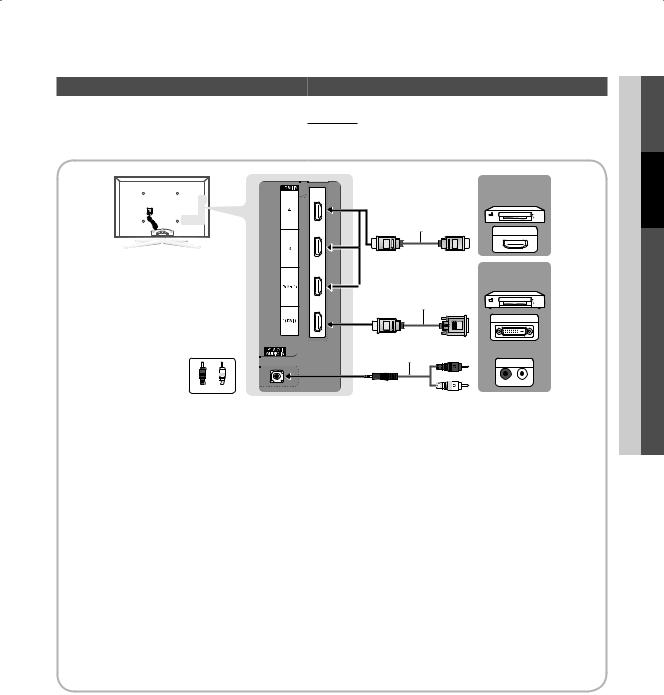
Connections
Connecting to an AV Device
Using an HDMI or HDMI/DVI Cable: HD connection (up to 1080p)
We recommend using the HDMI connection for the best quality HD picture.
Available devices: DVD, Blu-ray player, HD cable box, HD STB (Set-Top-Box) satellite receiver
Device
HDMI Cable (Not Supplied)
HDMI OUT
Device
HDMI to DVI Cable (Not Supplied)
DVI OUT
Audio Cable (Not Supplied)
AUDIO OUT
R W
R-AUDIO-L
Red White
HDMI IN 1(DVI), 2(ARC), 3, 4, PC/DVI AUDIO IN
xx For better picture and audio quality, connect to a digital device using an HDMI cable.
xx An HDMI cable supports digital video and audio signals, and does not require an audio cable.
–– To connect the TV to a digital device that does not support HDMI output, use an HDMI/DVI and audio cables.
xx The picture may not display normally (if at all) or the audio may not work if an external device that uses an older version of HDMI mode is connected to the TV. If such a problem occurs, ask the manufacturer of the external device about the HDMI version and, if out of date, request an upgrade.
xx Be sure to use an HDMI cable with a thickness of 14 mm or less.
xx Be sure to purchase a certified HDMI cable. Otherwise, the picture may not display or a connection error may occur.
xx A basic high-speed HDMI cable or one with ethernet is recommended. This product does not support the ethernet function via HDMI.
xx This product supports the 3D and ARC (Audio Return Channel) functions via an HDMI cable. Note that the ARC function is supported by the HDMI IN 2(ARC) port only.
––If 3D Auto View is set to On, some functions such as Internet@TV may be disabled. In this case, set 3D Auto View or 3D Mode to Off.
xx The ARC function allows digital audio to output via the HDMI IN 2(ARC) port. It can be enabled only when the TV is connected with an audio receiver that supports the ARC function.
Connections 02
English 9
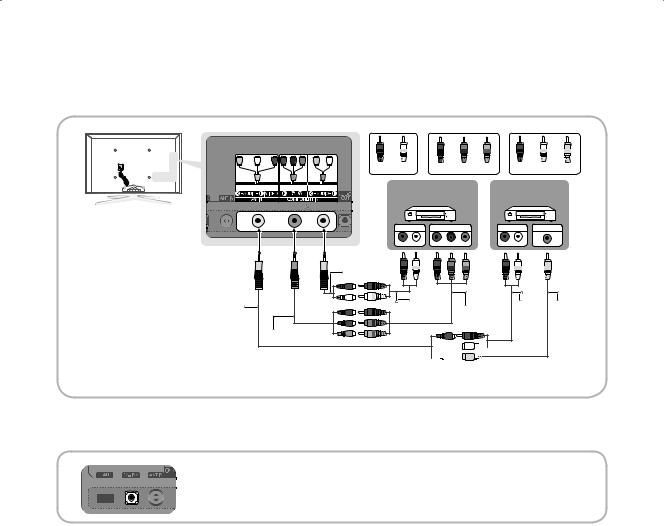
Connections
Using a Component (up to 1080p) or Audio/Video (480i only) Cable
Available devices: DVD, Blu-ray player, cable box, STB satellite receiver, VCR
R
W
R B G R
W
Y
Red White |
Red |
|
Blue Green |
Red |
White Yellow |
Device |
|
|
Device |
||
AUDIO OUT |
COMPONENT OUT |
AUDIO OUT |
VIDEO OUT |
||
R-AUDIO-L |
PR |
PB |
Y |
R-AUDIO-L |
|
R W |
R |
B |
G |
R W |
Y |
Component Sound in |
|
|
|
|
|
Adapter (Supplied) |
|
|
|
|
|
R |
W |
Audio Cable |
|
|
|
|
AV Adapter (Supplied) |
|
Audio Cable |
Video Cable |
||
(Not Supplied) |
Component Cable |
||||
(Not Supplied) |
(Not Supplied) |
||||
R |
|
||||
|
|
(Not Supplied) |
|
|
Component Adapter (Supplied)
G B R




 Y W
Y W








For better picture quality, the Component connection is recommended over the A/V connection.
Using an EX-Link Cable Connection
Available Devices: External devices that support EX-Link.
EX-LINK: Connector for service only.
10 English
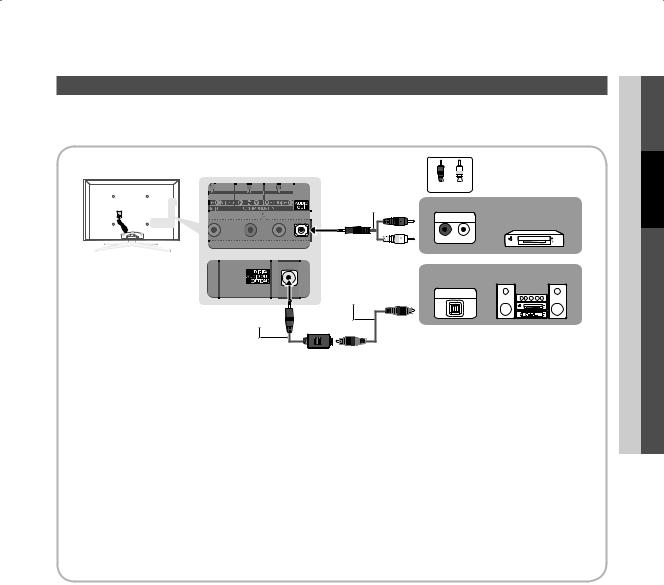
Connecting to an Audio Device
Using an Optical (Digital) or Audio (Analog) Cable Connection
Available devices: Digital Audio System, Amplifier, DVD home theater
|
R |
W |
|
|
Red |
White |
|
Audio Cable (Not Supplied) |
AUDIO IN |
Amplifier / |
|
|
DVD home theater |
||
|
|
|
|
|
R-AUDIO-L |
|
|
|
|
|
Digital Audio System |
Optical Cable (Not Supplied) |
OPTICAL |
|
|
|
|
|
|
Optical Adapter (Supplied)
DIGITAL AUDIO OUT (OPTICAL)
xx When a Digital Audio System is connected to the DIGITAL AUDIO OUT (OPTICAL) jack, decrease the volume of both the TV and the system.
xx 5.1 CH (channel) audio is available when the TV is connected to an external device supporting 5.1 CH.
xx When the receiver (home theater) is set to on, you can hear sound output from the TV’s optical jack. When the TV is receiving a DTV signal, the TV will send 5.1 CH sound to the home theater receiver. When the source is a digital component such as a DVD / Blu-ray player / cable box / STB (Set-Top-Box) satellite receiver and is connected to the TV via HDMI, only 2 CH audio will be heard from the home theater receiver. If you want to hear 5.1 CH audio, connect the digital audio out jack from your DVD / Blu-ray player / cable box / STB satellite receiver directly to an amplifier or home theater.
AUDIO OUT: Connects to the audio input jacks on your amplifier/DVD home theater. xx When connecting, use the appropriate connector.
xx When an audio amplifier is connected to the AUDIO OUT jacks: Decrease the volume of the TV and adjust the volume level with the amplifier’s volume control.
Connections 02
English 11
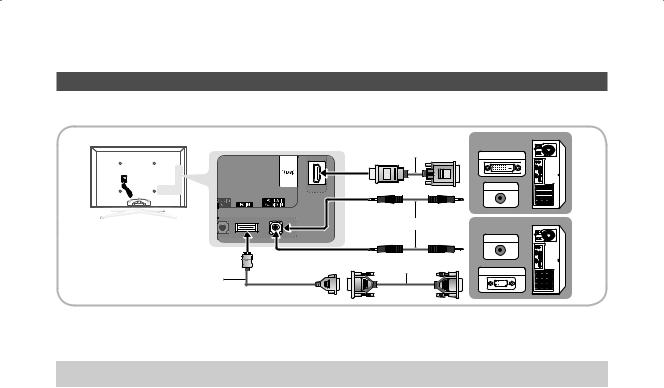
Connections
Connecting to a PC
Using an HDMI/DVI cable or a D-sub cable
HDMI to DVI Cable (Not Supplied) |
DVI OUT |
|
|
|
AUDIO OUT |
Audio Cable (Not Supplied) |
|
|
AUDIO OUT |
D-Sub Cable (Not Supplied) |
PC OUT |
|
|
PCAdapter (Supplied) |
|
Display Modes (D-Sub and HDMI/DVI Input)
Optimal resolution is 1920 X 1080 @ 60 Hz.
Mode |
Resolution |
Horizontal Frequency |
Vertical Frequency |
Pixel Clock Frequency |
Sync Polarity |
|
(KHz) |
(Hz) |
(MHz) |
(H / V) |
|||
|
|
|||||
|
|
|
|
|
|
|
IBM |
640 x 350 |
31.469 |
70.086 |
25.175 |
+/- |
|
720 x 400 |
31.469 |
70.087 |
28.322 |
-/+ |
||
|
||||||
|
640 x 480 |
35.000 |
66.667 |
30.240 |
-/- |
|
MAC |
832 x 624 |
49.726 |
74.551 |
57.284 |
-/- |
|
|
1152 x 870 |
68.681 |
75.062 |
100.000 |
-/- |
|
|
|
|
|
|
|
|
|
720 x 576 |
35.910 |
59.950 |
32.750 |
-/+ |
|
VESA CVT |
1152 x 864 |
53.783 |
59.959 |
81.750 |
-/+ |
|
1280 x 720 |
56.456 |
74.777 |
95.750 |
-/+ |
||
|
||||||
|
1280 x 960 |
75.231 |
74.857 |
130.000 |
-/+ |
|
|
|
|
|
|
|
|
|
640 x 480 |
31.469 |
59.940 |
25.175 |
-/- |
|
|
640 x 480 |
37.861 |
72.809 |
31.500 |
-/- |
|
|
640 x 480 |
37.500 |
75.000 |
31.500 |
-/- |
|
|
800 x 600 |
37.879 |
60.317 |
40.000 |
+/+ |
|
|
800 x 600 |
48.077 |
72.188 |
50.000 |
+/+ |
|
|
800 x 600 |
46.875 |
75.000 |
49.500 |
+/+ |
|
|
1024 x 768 |
48.363 |
60.004 |
65.000 |
-/- |
|
|
1024 x 768 |
56.476 |
70.069 |
75.000 |
-/- |
|
|
1024 x 768 |
60.023 |
75.029 |
78.750 |
+/+ |
|
VESA DMT |
1152 x 864 |
67.500 |
75.000 |
108.000 |
+/+ |
|
1280 x 1024 |
63.981 |
60.020 |
108.000 |
+/+ |
||
|
||||||
|
1280 x 1024 |
79.976 |
75.025 |
135.000 |
+/+ |
|
|
1280 x 720 |
45.000 |
60.000 |
74.250 |
+/+ |
|
|
1280 x 800 |
49.702 |
59.810 |
83.500 |
-/+ |
|
|
1280 x 800 |
62.795 |
74.934 |
106.500 |
-/+ |
|
|
1280 x 960 |
60.000 |
60.000 |
108.000 |
+/+ |
|
|
1360 x 768 |
47.712 |
60.015 |
85.500 |
+/+ |
|
|
1440 x 900 |
55.935 |
59.887 |
106.500 |
-/+ |
|
|
1440 x 900 |
70.635 |
74.984 |
136.750 |
-/+ |
|
|
1680 x 1050 |
65.290 |
59.954 |
146.250 |
-/+ |
|
|
|
|
|
|
|
|
VESA GTF |
1280 x 720 |
52.500 |
70.000 |
89.040 |
-/+ |
|
1280 x 1024 |
74.620 |
70.000 |
128.943 |
-/- |
||
|
||||||
|
|
|
|
|
|
|
VESA DMT / DTV CEA |
1920 x 1080p |
67.500 |
60.000 |
148.500 |
+/+ |
|
|
|
|
|
|
|
NOTE
xx For HDMI/DVI cable connection, you must use the HDMI IN 1(DVI) jack. xx The interlace mode is not supported.
xx The set may operate abnormally if a non-standard video format is selected.
xx Separate and Composite modes are supported. SOG(Sync On Green) is not supported.
12 English
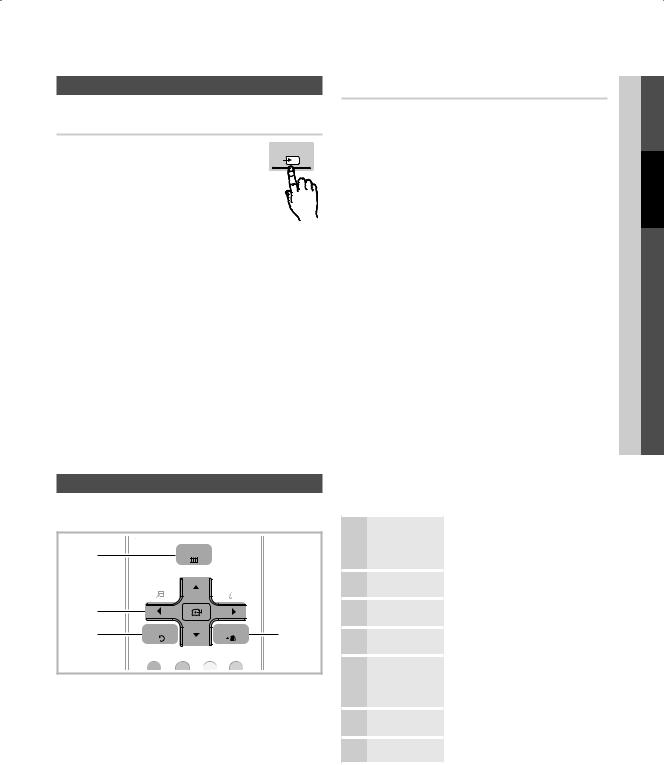
Changing the Input Source
Source List |
|
|
Use to select TV or an external input sources |
SOURCE |
|
such as a DVD / Blu-ray player / cable box / |
||
|
||
STB satellite receiver. |
|
OO MENUm→ Input → Source List → ENTERE
■■ TV / PC / AV / Component / HDMI1/DVI / HDMI2 / HDMI3 / HDMI4 / USB
You can only choose external devices that are connected to the TV. In the Source List, connected inputs will be highlighted.
In the Source List, PC is always activated.
Basic Features
How to Navigate Menus
Before using the TV, follow the steps below to learn how to navigate the menu and select and adjust different functions.
1 |
CONTENT |
MENU |
INTERNET |
|
@ TV |
|
|||
|
|
|
|
|
2 |
|
|
|
|
3 |
RETURN |
|
EXIT |
4 |
|
|
|
1MENU button: Displays the main on-screen menu.
2ENTERE/ Direction button: Move the cursor and select an item. Confirm the setting.
3RETURN button: Returns to the previous menu.
4EXIT button: Exits the on-screen menu.
Edit Name
OO MENUm→ Input → Edit Name → ENTERE
■■ VCR / DVD / Cable STB / Satellite STB / PVR STB / AV Receiver / Game / Camcorder / PC / DVI PC / DVI Devices / TV / IPTV / Blu-ray / HD DVD / DMA: Name the device connected to the input jacks to make your input source selection easier.
When a PC with a resolution of 1920 x 1080 @ 60Hz is connected to the HDMI IN 1(DVI) port, you should set the TV to DVI PC mode under Edit Name.
When connecting an HDMI/DVI cable to the HDMI IN 1(DVI) port, you should set the TV to DVI PC or DVI Devices mode under Edit Name.
How to Operate the OSD (On Screen Display)
The access step may differ depending on the selected menu.
1 |
MENUm |
2 |
▲ / ▼ |
3 |
ENTERE |
4 |
▲ / ▼ |
5 |
◄ / ► |
6 |
ENTER E |
7 |
EXIT e |
The main menu options appear on the screen:
Picture, Sound, Channel, Setup, Input, Application, Support.
Select an icon with the ▲ or ▼ button.
Press ENTEREto access the sub-menu.
Select the desired submenu with the ▲ or ▼ button.
Adjust the value of an item with the ◄ or ► button. The adjustment in the OSD may differ depending on the selected menu.
Press ENTEREto confirm the selection.
Press EXIT.
Connections 02
English 13
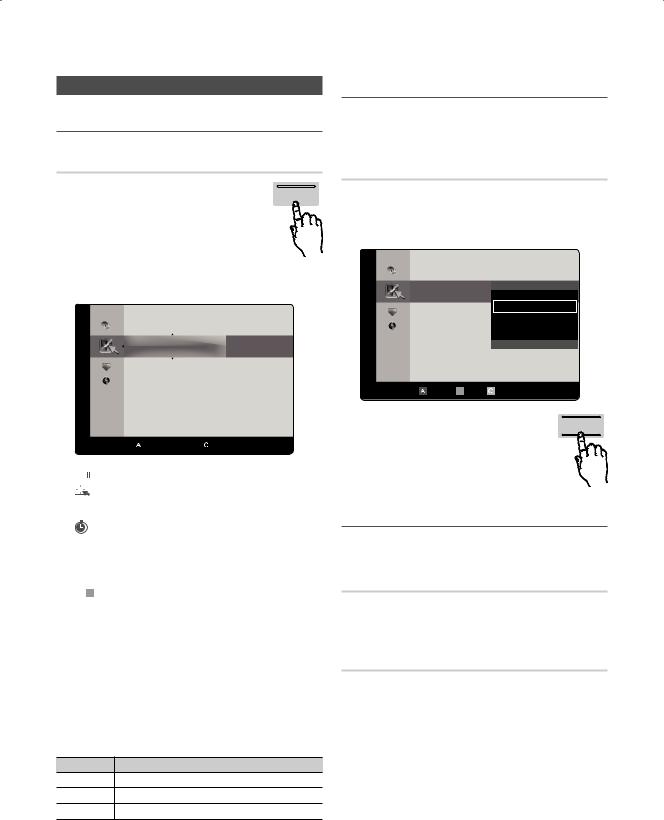
Basic Features
Channel Menu
¦¦ Seeing Channels
Channel List
Add, delete or set Favorite channels and use |
CH LIST |
the program guide for digital broadcasts. |
OO MENUm→ Channel → Channel List → ENTERE
Select a channel in the All Channels, Added Channels, Favorite or Programmed screen by pressing the ▲ / ▼ and ENTEREbuttons. Then you can watch the selected channel.
|
6 |
|
|
|
Air |
|||
Added |
6-1 |
* TV #6 |
||||||
7 |
|
|
|
Air |
||||
Channels |
8 |
|
|
|
Air |
|||
|
|
|
|
|||||
|
9 |
|
|
|
Air |
|||
|
9-1 |
* TV #9 |
||||||
|
10 |
|
|
|
Air |
|||
|
10-1 |
* TV #10 |
||||||
|
11-1 |
* TV #11 |
||||||
Air |
|
|
Antenna |
|
|
Zoom |
|
Select kPage TTools |
|
|
B |
|
|||||
■■  All Channels: Shows all currently available channels. ■■
All Channels: Shows all currently available channels. ■■ 

 Added Channels: Shows all added channels.
Added Channels: Shows all added channels.
■■ *Favorite: Shows all favorite channels.
■■ Programmed: Shows all currently reserved programs.
Using the color buttons with the Channel List xx Red (Antenna): Switches to Air or Cable.
Red (Antenna): Switches to Air or Cable.
xx B Green (Zoom): Enlarges or shrinks a channel number.
xx Yellow (Select): Selects multiple channel lists. Select desired channels and press the Yellow button to set all the selected channels at the same time. The cmark appears to the left of the selected channels.
Yellow (Select): Selects multiple channel lists. Select desired channels and press the Yellow button to set all the selected channels at the same time. The cmark appears to the left of the selected channels.
xx k(Page): Move to next or previous page.
xx T(Tools): Displays the Channel List option menu. (The options menus may differ depending on the situation.)
Channel Status Display Icons
Icons Operations
c A channel selected.
*A channel set as a Favorite.
) A reserved Program.
¦¦ Using Favorite Channels
OO MENUm→ Channel → Channel List → ENTERE
Add to Favorite / Delete from Favorite t
Set channels you watch frequently as Favorites.
1.Select a channel and press the TOOLS button.
2.Add or delete a channel using the Add to Favorite or
Delete from Favorite menu respectively.
|
6 |
Air |
|
|
Added |
6-1 |
* TV #6 |
|
|
7 |
Air |
|
||
Delete |
||||
|
||||
Channels |
8 |
Air |
Add to Favorite |
|
Timer Viewing |
||||
10 |
Air |
|||
|
9 |
Air |
Channel Name Edit |
|
|
9-1 |
* TV #9 |
Select All |
|
|
10-1 |
* TV #10 |
|
|
|
|
|||
|
11-1 |
* TV #11 |
|
Air |
Antenna B Zoom Select kPage |
TTools |
To show all Favorite channels, click on the |
FAV.CH |
|
button shown on the right. |
||
¦¦ Memorizing Channels
OO MENUm→ Channel → ENTERE
Antenna (Air / Cable) t
Before your television can begin memorizing the available channels, you must specify the type of signal source that is connected to the TV (i.e. an Air or a Cable system).
Auto Program
■■ Air: Air antenna signal.
■■ Cable: Cable antenna signal. ■■ Auto: Air and Cable antenna.
14 English

NOTE
xx When selecting the Cable TV system: STD, HRC and IRC identify various types of cable TV systems. Contact your local cable company to identify the type of cable system that exists in your particular area. At this point, the signal source has been selected.
xx After all the available channels are stored, it starts to remove scrambled channels. The Auto Program menu then reappears.
¦¦ Editing Channels
OO MENUm→ Channel → Channel List → ENTERE
Channel Name Edit
1.Select a channel and press the TOOLS button.
2.Edit the channel name using the Channel Name Edit menu.
■■ Channel Name Edit (analog channels only): Assign your own channel name.
¦¦ Other Features
OO MENUm→ Channel → ENTERE
Clear Scrambled Channel
This function is used to filter out scrambled channels after Auto Program is completed. This process may take up to 20~30 minutes.
How to Stop Searching Scrambled Channels
1.Press the ENTEREbutton to select Stop.
2.Press the ◄ button to select Yes.
3.Press the ENTEREbutton.
This function is only available in Cable mode.
Channel List
Channel List Option Menu
Set each channel using the Channel List menu options (Add / Delete, Timer Viewing, Select All / Deselect All). Option menu items may differ depending on the channel status.
1.Select a channel and press the TOOLS button.
2.Select a function and change its settings.
■■ Add / Delete: Delete or add a channel to display the channels you want.
NOTE
xx All deleted channels will be shown on the All Channels menu.
xx A gray-colored channel indicates the channel has been deleted.
xx The Add menu only appears for deleted channels.
xx Delete a channel from the Added Channels or Favorite menu in the same manner.
■■ Timer Viewing: You can set a desired channel to be displayed automatically at the reserved time. Set the current time first to use this function.
1.Press the ◄ / ► / ▲ / ▼ buttons to select the desired channel in Channel List.
2.Press the TOOLS button, then select Timer Viewing.
3.Scroll up or down to adjust the settings in the box, or use the numeric buttons on your remote to enter the date and time.
If you selected Once, Every Week or EveryDay
in Repeat you can enter the date you want.
4.Select OK, then press the ENTEREbutton when done.
NOTE
xx Only memorized channels can be reserved.
xx Reserved programs will be displayed in the
Programmed menu.
xx When a digital channel is selected, press the ► button to view the digital program.
■■ Select All: Select all the channels in the channel list. ■■ Deselect All: Deselect all the selected channels.
You can only select Deselect All when one or more channels are selected.
 Programmed
Programmed
(in Channel List)
You can view, modify or delete a show you have reserved to watch. Programmed timer viewing is displayed here. Highlight a program and press the TOOLS button to display Options.
■■ Change Info: Change a show you have reserved to watch. Begin with step 3 of “Timer Viewing” above.
■■ Cancel Schedules: Cancel a show you have reserved to watch.
This deletes the highlighted or selected program(s).
Features Basic 03
English 15

Basic Features
■■ Information: Display a show you have reserved to watch. (You can also change the reservation Information.)
Alternatively, you can view Information by highlighting a program and pressing the ENTEREbutton.
■■ Select All / Deselect All: Select or deselect all reserved programs.
Fine Tune
(analog channels only)
If the reception is clear, you do not have to fine tune the channel, as this is done automatically during the search and store operation. If the signal is weak or distorted, fine tune the channel manually. Scroll to the left or right until the image is clear.
Settings are applied to the channel you're currently watching.
Fine tuned channels that have been saved are marked with an asterisk “*” on the right-hand side of the channel number in the channel banner.
To reset the fine-tuning, select Reset.
Picture Menu
¦¦ Changing the Preset Picture Mode
OO MENUm→ Picture → Mode → ENTERE
Mode t
Select your preferred picture type.
■■ Dynamic: Suitable for a bright room.
■■ Standard: Suitable for a normal environment. ■■ Natural: Suitable for reducing eye strain.
Natural is not available in PC mode.
■■ Movie: Suitable for watching movies in a dark room.
¦¦ Adjusting Picture Settings
OO MENUm→ Picture → ENTERE
Backlight / Contrast / Brightness / Sharpness / Color / Tint (G/R)
Your television has several setting options for picture quality control.
NOTE
xx When you make changes to Backlight, Contrast, Brightness, Sharpness, Color or Tint (G/R) the OSD will be adjusted accordingly.
xx In PC mode, you can only make changes to
Backlight, Contrast and Brightness.
xx Settings can be adjusted and stored for each external device connected to the TV.
¦¦ Economical Solutions
The Eco Function can be used to enhance your power savings.
Eco Solution
OO MENUm→ Picture → Eco Solution → ENTERE
■■ Energy Saving (Off / Low / Medium / High / Picture Off / Auto): This adjusts the brightness of the TV in order to reduce power consumption. If you select Picture Off, the screen is turned off, but the sound remains on. Press any button except the volume button to turn on the screen.
■■ Eco Sensor (Off / On): To enhance your power savings; the picture settings will automatically adapt to the light in the room.
If you adjust the Backlight, the Eco Sensor will be set to Off.
Min Backlight: When Eco sensor is On, the minimum screen brightness can be adjusted manually.
If Eco Sensor is On, the display brightness may change (become slightly darker in most cases) depending on the surrounding light intensity.
■■ No Signal Power Off (Off / 15 min. / 30 min. / 60 min.): To avoid unnecessary energy consumption, set how long you want the TV to remain on if it's not receiving a signal.
Disabled when the PC is in power saving mode.
16 English

¦¦ Changing the Picture Options
Advanced Settings
OO MENUm→ Picture → Advanced Settings → ENTERE
(Advanced Settings are available in Standard / Movie mode)
Compared to previous models, new Samsung TVs have a more precise picture.
In PC mode, you can only make changes to Dynamic Contrast, Gamma, White Balance and LED Motion Plus.
Advanced Settings
Black Tone |
: Off |
► |
Dynamic Contrast |
: Medium |
|
Shadow Detail |
: -2 |
|
Gamma |
: 0 |
|
Expert Pattern |
: Off |
|
RGB Only Mode |
: Off |
|
Color Space |
: Native |
|
|
▼ |
|
|
UMove EEnter |
RReturn |
■■ Black Tone (Off / Dark / Darker / Darkest): Select the black level to adjust the screen depth.
■■ Dynamic Contrast (Off / Low / Medium / High): Adjust the screen contrast.
■■ Shadow Detail (-2~+2): Increase the brightness of dark images.
■■ Gamma: Adjust the primary color intensity.
■■ Expert Pattern (Off / Pattern1 / Pattern2): By running the Expert Pattern function, the picture can be calibrated. If the OSD menu disappears or a menu
other than the Picture menu is opened, the calibration is saved and the Expert Pattern window disappears.
Off: Turns the Expert Pattern function off.
Pattern1: This is a test screen designed to demonstrate the affects of display settings on shades.
Pattern2: This is a test screen designed to demonstrate the affects of display settings on colors.
After selecting Pattern1 or Pattern2, you can adjust any of the advanced settings to the desired effect.
While the Expert Pattern is running, sound is not output.
Only enabled in DTV, Component and HDMI modes.
■■ RGB Only Mode (Off / Red / Green / Blue): Displays the Red, Green and Blue color for making fine adjustments to the hue and saturation.
■■ Color Space (Auto / Native / Custom): Adjust the range of colors available to create the image. To adjust
Color, Red, Green, Blue and Reset, set Color Space to Custom.
■■ White Balance: Adjust the color temperature for a more natural picture.
R-Offset / G-Offset / B-Offset: Adjust each color's (red, green, blue) darkness.
R-Gain / G-Gain / B-Gain: Adjust each color's (red, green, blue) brightness.
Reset: Resets the White Balance to it's default settings.
■■ 10p White Balance (Off / On): Controls the white balance in 10 point intervals by adjusting the red, green, and blue brightness.
Available when the picture mode is set to Movie and when the external input is set to all input.
Some external devices may not support this function.
Interval: Select interval to adjust. Red: Adjust the red level. Green: Adjust the green level. Blue: Adjust the blue level.
Reset: Resets the 10p White Balance to its default settings.
■■ Flesh Tone: Emphasize pink “Flesh Tone.”
■■ Edge Enhancement (Off / On): Emphasize object boundaries.
■■ xvYCC (Off / On): Setting the xvYCC mode on increases detail and color space when watching movies from an external device (e.g. BD/DVD player) connected to the HDMI or Component IN jacks.
Available when the picture mode is set to Movie and when the external input is set to HDMI or Component.
Some external devices may not support this function.
■■ LED Motion Plus (Off / On): Removes drag from fast scenes with a lot of movement to provide a clear picture.
Features Basic 03
English 17
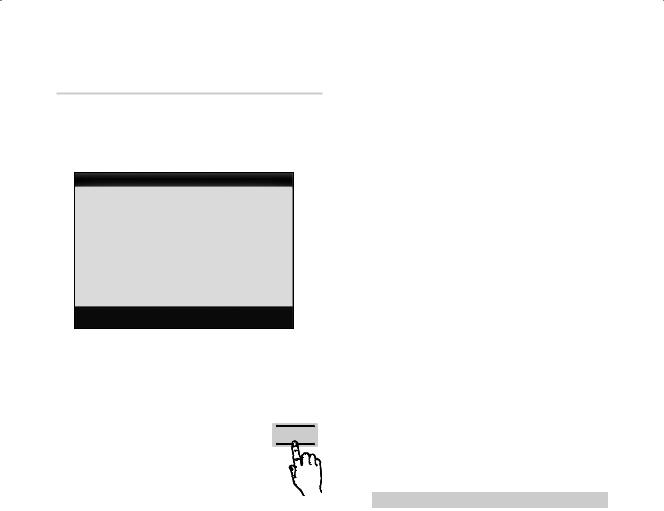
Basic Features
Picture Options
OO MENUm→ Picture → Picture Options → ENTERE
In PC mode, you can only make changes to the Color Tone, Size and Auto Protection Time.
Picture Options
Color Tone |
: Normal |
► |
Size |
: 16:9 |
|
Digital Noise Filter |
:Auto |
|
MPEG Noise Filter |
:Auto |
|
HDMI Black Level |
: Normal |
|
Film Mode |
: Off |
|
Auto Motion Plus |
: Standard |
|
|
▼ |
|
|
UMove EEnter |
RReturn |
■■ Color Tone (Cool / Normal / Warm1 / Warm2)
Warm1 or Warm2 will be deactivated when the picture mode is Dynamic.
Settings can be adjusted and stored for each external device connected to an input on the TV.
■■ Size: Your cable box/satellite receiver may
have its own set of screen sizes as well. P.SIZE However, we highly recommend you use
16:9 mode most of the time. 16:9 : Sets the picture to 16:9 wide mode. Zoom1: Use for moderate magnification.
Zoom2: Use for a stronger magnification.
Wide Fit: Enlarges the aspect ratio of the picture to fit the entire screen.
Available with HD 1080i / 720p signals in 16:9 mode.
4:3 : Sets the picture to basic (4:3) mode.
Do not watch in 4:3 format for a long time. Traces of borders displayed on the left, right and center of the screen may cause image retention(screen burn) which are not covered by the warranty.
Screen Fit: Displays the full image without any cut-off when HDMI (720p / 1080i / 1080p) or Component (1080i / 1080p) signals are inputted.
NOTE
xx When Double (À, Œ) mode has been set in PIP (Picture-in-Picture), the Picture Size cannot be set.
xx After selecting Zoom1, Zoom2 or Wide Fit:
1.Press the ► button to select Position.
2.Press the ENTEREbutton.
3.Press the ▲ or ▼ button to move the picture up or down.
4.Press the ENTEREbutton.
5.Press the ► button to select Reset.
6.Press the ENTEREbutton to reset the picture to its default position.
xx After selecting Screen Fit in HDMI (1080i/1080p) or Component (1080i/1080p) mode, you may need to center the picture:
1.Press the ◄ or ► button to select Position.
2.Press the ENTEREbutton.
3.Press the ▲, ▼, ◄ or ► button to move the picture.
4.Press the ENTEREbutton.
5.Press the ◄ or ► button to select Reset.
6.Press the ENTEREbutton.
xx HD (High Definition): 16:9 - 1080i/1080p (1920x1080), 720p (1280x720)
xx Settings can be adjusted and stored for each external device you have connected to an input on the TV.
Input Source |
Picture Size |
ATV, AV, |
16:9, Zoom1, |
Component (480i, 480p) |
Zoom2, 4:3 |
DTV(1080i), |
16:9, 4:3, Wide Fit, |
Component (1080i, 1080p), |
Screen Fit |
HDMI (720p, 1080i, 1080p) |
|
PC |
16:9, 4:3 |
■■ Digital Noise Filter (Off / Low / Medium / High / Auto / Auto Visualization): If the broadcast signal received by your TV is weak, you can activate the Digital Noise Filter feature to reduce any static and ghosting that may appear on the screen.
When the signal is weak, try other options until the best picture is displayed.
Auto Visualization: When changing analog channels, displays signal strength.
Only available for analog channels.
When bar is green, you are receiving the best possible signal.
18 English

■■ MPEG Noise Filter (Off / Low / Medium / High / Auto): Reduces MPEG noise to provide improved picture quality.
■■ HDMI Black Level (Normal / Low): Selects the black level on the screen to adjust the screen depth.
Available only in HDMI mode.
■■ Film Mode (Off / Auto1 / Auto2): Sets the TV to automatically sense and process film signals from all sources and adjusts the picture for optimum quality.
Available in TV, AV, COMPONENT (480i / 1080i) and HDMI (480i / 1080i).
■■ Auto Motion Plus (Off / Clear / Standard / Smooth / Custom / Demo): Removes drag from fast scenes with a lot of movement to provide a clearer picture.
The info screen on your TV displays the resolution and frequency of the incoming video signal (60 Hz). This displayed frequency is not what the
TV is displaying by using the Auto Motion Plus function.
If noise occurs on the screen, please set the
Auto Motion Plus to Off. If Auto Motion Plus is Custom, you can set up the Blur Reduction, Judder Reduction or Reset manually.
If Auto Motion Plus is Demo, you can compare the difference between on and off modes.
Blur Reduction: Adjusts the blur reduction level from video sources.
Judder Reduction: Adjusts the judder reduction level from video sources when playing films.
Reset: Reset the custom settings.
■■ Auto Protection Time (2 hours / 4 hours / 8 hours / 10 hours / Off): Set the time the screen remains idle
with a still image until the screen saver is activated. The screen saver prevents the formation of ghost images on the screen.
¦¦ Viewing TV using the 3D function
OO MENUm→ Picture → 3D → ENTERE
IMPORTANT HEALTH AND SAFETY INFORMATION FOR 3D PICTURES.
Read and understand the following safety information before using the TV’s 3D function.
[[WARNING
xx Some viewers may experience discomfort while viewing 3D TV such as dizziness, nausea and headaches. If you experience any such symptom, stop viewing 3D TV, remove 3D Active Glasses and rest.
xx Watching 3D images for an extended period of time may cause eye strain. If you feel eye strain, stop viewing 3D TV, remove your 3D Active Glasses and rest.
xx A responsible adult should frequently check on children who are using the 3D function. If there are any reports of tired eyes, headaches, dizziness, or nausea, have the child stop viewing 3D TV and rest.
xx Do not use the 3D Active Glasses for other purposes (such as general eyeglasses, sunglasses, protective goggles, etc.)
xx Do not use the 3D function or 3D Active Glasses while walking or moving around. Using the 3D function or 3D Active Glasses while moving around may result in injuries due to running into objects, tripping, and/or falling.
Features Basic 03
English 19
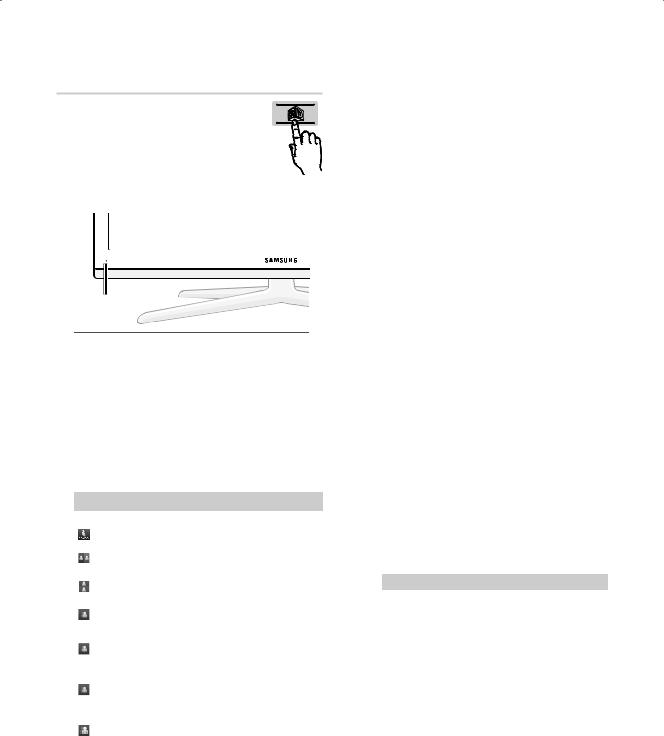
Basic Features
3D
This exciting new feature enables you to view
3D content. In order to fully enjoy this feature, you must purchase a pair of Samsung 3D Active Glasses (SSG-2100AB, SSG-2200AR, SSG-2200KR) to view 3D video.
Samsung 3D Active Glasses are sold separately. For more detailed purchasing
information, contact the retailer where you purchased this TV.
3D emitter
If there is any obstacle between the emitter and 3D Active Glasses, the proper 3D effect may not be obtained.
■■ 3D Mode: Select the 3D input format.
If you want to feel the 3D effect fully, please wear the 3D Active Glasses first, and then select 3D Mode from the list below that provides the best 3d viewing experience.
When watching 3D images, turn on 3D Active Glasses.
3D Mode |
Operation |
|
|
|
|
Off |
Turns the 3D function off. |
|
|
2D → 3D |
Changes a 2D image to 3D. |
|
Side by Side |
Displays two images next to |
|
each other. |
|
|
|
|
|
Top & Bottom |
Displays one image above |
|
another. |
|
|
|
|
|
Line by Line |
Displays the images for the left |
|
and right eye alternately in rows. |
|
|
|
|
|
|
Displays the images for the |
|
Vertical Stripe |
left and right eye alternately in |
|
|
columns. |
|
Checker |
Displays the images for the |
|
left and right eye alternately in |
|
|
Board |
|
|
pixels. |
|
|
|
|
|
Frame |
Displays the images for the |
|
left and right eye alternately in |
|
|
Sequential |
|
|
frames. |
|
|
|
|
“Side by Side” and “Top & Bottom” are available when the resolution is 720p, 1080i and 1080p in DTV, HDMI and USB mode or when set to PC and the PC is connected through an HDMI/DVI cable.
“Vertical Strip”, “Line by Line” and “Checker Board” are available when the resolution is set to PC and the PC is connected through an HDMI/ DVI cable.
“Frame Sequential” displays the frequency (60Hz only) when the resolution is set to PC.
■■ 3D → 2D (Off / On): Displays the image for the left eye only.
This function is deactivated when 3D Mode set to “2D → 3D” or Off.
■■ 3D View point: The overall adjustment of 3D perspective.
This function is deactivated when 3D Mode set to “2D → 3D” or Off.
■■ Depth: Adjusts focus / depth in “2D → 3D” mode.
This function is only activated when the 3D Mode is “2D → 3D”.
■■ Picture Correction: Adjusts the images for the left and right eye.
■■ 3D Auto View (Off / On): If 3D Auto View is set to On, a “Side-by-Side” format HDMI signal with one of the resolutions below is automatically switched to 3D. Here, correct 3D information must be sent from the Standard HDMI 3D Format.
If a 3D failure occurs due to a 3D information error, set 3D Auto View to Off and manually select a 3D Mode using the 3D button or corresponding menu.
Support resolution (16:9 only)
Resolution |
Frequency (Hz) |
|
1280 x 720p |
60 |
Hz |
1920 x 1080i |
60 |
Hz |
1920 x 1080p |
24 / 30 |
/ 60 Hz |
■■ 3D Optimize: The overall adjustment of 3D effect.
20 English

Resolution supported for HDMI PC mode
The resolution for HDMI PC mode is optimized to 1920 x 1080 input.
An input resolution other than 1920 x 1080 may not be displayed properly in 3D display or full screen mode.
How to watch the 3D image
3D
To watch in 3D, wear 3D glasses and press the power button on the glasses.
Viewing 3D TV motion pictures for long periods may cause eye fatigue and/or dizziness.
OK Cancel
LMove EEnter eExit
3D
UsiingttheLEFT//RIIGHTkeysonttherremotecontrol, sellectt tthe iicon suitable fforr tthe piictture on scrreen..
LMove EEntter eExit
1.Press the CONTENT button, then the Content View menu will appear.
2.Press the ◄ or ► button, then select 3D.
To watch in 3D, wear 3D Active Glasses and press the power button on the glasses.
3.Select OK, then press the ENTEREbutton.
4.Using the ◄ or ► buttons on your remote control, select the 3D Mode of the image you want to view.
Some 3D modes may not be available depending
on the format of the image source.
Supported formats and operating specifications for Standard HDMI 3D
The 3D formats indicated below are recommended by the HDMI association and must be supported.
Source signal format |
Standard HDMI 1.4 3D |
1920x1080p@24Hz x 2 |
1920x2205p@24Hz |
1280x720p@60Hz x 2 |
1280x1470p@60Hz |
|
|
The mode is automatically switched to 3D in one of the source signal formats above.
For the Standard HDMI 3D format with 24Hz, the TV is optimized as follows:
––Resolution First Display Mode: If Auto Motion Plus is set to Off, Clear or Standard, you can watch the video at a high resolution optimized to the resolution of the source video.
––Judder Reduction Display Mode: When Auto Motion Plus is set to Smooth or Custom, you can watch a smooth picture without judder.
Before using 3D function...
NOTE
xx You may notice a small amount of screen flickering when watching 3D images in poor light conditions (from a strobe light, etc.), or under a fluorescent lamp (50Hz ~ 60Hz) or 3 wavelength lamp. If so, dim the light or turn the lamp off.
xx 3D mode is automatically disabled in following cases: when changing a channel or the input source, or accessing Media Play or Internet@TV.
xx Some Picture functions are disabled in 3D mode. xx PIP is not supported in 3D mode.
xx 3D Active Glasses from other manufacturers may not be supported.
xx When the TV is initially powered on, it may take some time until the 3D display is optimized.
xx The 3D Active Glasses may not work properly if there is any other 3D product or electronic devices turned on near the glasses or TV. If there is a problem, keep other electronic devices as far away as possible from the 3D Active Glasses.
xx Photos of Media Play are shown in “2D → 3D” mode only.
xx If you lie on your side while watching TV with 3D active glasses, the picture may look dark or may not be visible.
xx Be sure to stay within the viewing angle and optimum TV viewing distance when watching 3D pictures.
––Otherwise, you may not be able to enjoy proper 3D effects.
xx The ideal viewing distance should be three times or more the height of the screen. We recommend sitting with viewer's eyes on a level with the screen.
Features Basic 03
English 21
